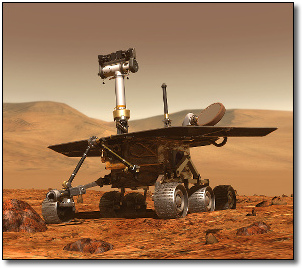
Image: NASA
 |
NASA's mars
rover, currently on the Martian surface, relies on critical solar PV
power. Image: NASA |
"Plastic solar cells have been around for a long time. We're trying
to use nanotechnology to improve their efficiency. Quantum dots may be the key
to improving the best crystalline cells available today and to making plastic
solar cells better."
- Ryne Raffaelle, Lab Director at the Rhode Island Institute of Technology
Rochester, New York - September 24, 2004 [SolarAccess.com]
The success of the Mars Exploration Rovers is a sign of things to come in the
realm of space exploration. Robotic technology coupled with high efficiency
solar photovoltaic (PV) power sources will play an increasingly important part
in NASA's new Exploration Systems Mission Directorate - one of the biggest
initiatives since the Apollo Program. As part of this new effort, NASA is
demanding further development for solar PV power sources, and a New York State
research facility is the latest to take part.
NASA awarded Rochester Institute of Technology and its research partners at the
NASA Glenn Research Center and the Ohio Aerospace Institute, Jet Propulsion
Laboratory, Pennsylvania State University and the Space Vacuum Epitaxy Center at
the University of Houston US$6 million as part of the Human and Robotic
Technology program to study nanomaterials and nanostructure for space PV
technologies. RIT will receive $1.2 million in support of its role in the
project.
The four-year project, led by Sheila Bailey of the NASA Glenn Research Center,
is focused on the use of nanotechnology and nanomaterials like quantum dots, or
granules of semiconductor material, to develop the next generation of space
solar cells.
Scientists in RIT's NanoPower Laboratories will use plastic solar cells
containing nanomaterials to try to maximize energy conversion and exploit the
sun as an available power source.
"Plastic solar cells have been around for a long time," said Ryne
Raffaelle, director of the lab at RIT. "We're trying to use nanotechnology
to improve their efficiency. Quantum dots may be the key to improving the best
crystalline cells available today and to making plastic solar cells
better."
More efficient solar cells would upgrade the power supplies used in robotic
exploration, improving performance and range.
"The rovers have been remarkably successful," Raffaelle says.
"They are something that NASA wants to continue, but they need power. To
date, these rovers have relied upon solar power and I would expect that trend to
continue in the future."
The Exploration Systems Mission Directorate was established in response to
President Bush's space exploration policy to send astronauts on a return visit
to the moon by 2020 and to realize a manned trip to Mars. In light of a
staggering budget deficit and an ongoing, expensive war in Iraq, Bush's
ambitions for a costly manned trip to Mars received only tepid support from the
majority of Americans.
The silver lining, however, may prove to be advances in solar PV technology.
More efficient solar cells developed for NASA's robotic needs stand a chance to
revolutionize, or at least steer, the domestic solar PV market, which has been
searching for ways to lower the final cost per watt of PV.
RIT's involvement in the Human and Robotic Technology program is an extension of
previous collaborations between the NPRL and the Glenn Research Center that were
funded by NASA and the National Science Foundation.
Copyright © 1999 - 2004 - SolarAccess.com
Please visit www.solaraccess.com for great coverage on energy today!!